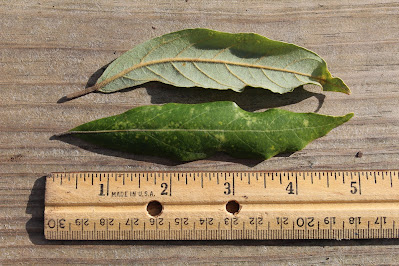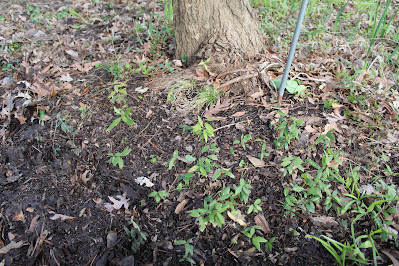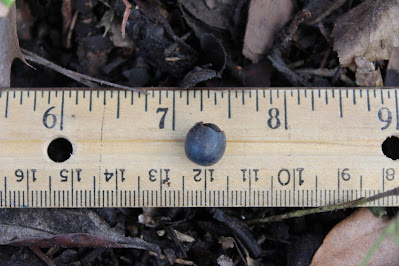 |
Our tree of the week is one of our evergreen species, a red bay (Persea borbonia), more than 20 years old, perhaps nearing 30. We previously discussed this tree during October of 2017, highlighting its fruit production. You can read that post here. Below, we have pictures of the red bay in the winter landscape.
|
 |
This specimen grows in the western floodplain, next to the long, wooden foot bridge that runs between the Student Union Building and the Fitness Center. Its neighbors include: Titi (Cyrilla racemiflora), Louisiana iris hybrids (Iris sp.), salt matrimony-vine (Lycium carolinianum), and ironwood (Carpinus caroliniana).
|
 |
The red bay is pictured center. Its trunk casts a long shadow on the ground.
|
 |
Red bays are especially nice this time of year because of the pretty green foliage. The leaves are also good for cooking; use them as you would a culinary bay leaf. Try them in gumbo, marinara sauce, or stews like borscht.
|
 |
Unfortunately, the leaves on this particular red bay are unsuitable for any culinary uses. The leaves are speckled with yellow spots and the margins curl, suggesting that the tree suffers from a disease.
|
 |
The most important disease afflicting red bays is Laurel Wilt, resulting from a fungus, Raffaelea lauricola. An invasive beetle, the ambrosia beetle, infects the tree with the fungus, which is studied due to its deleterious effects on avocado plantations in Florida. As red bay is prevalent across the Southeast, it is used to study the spread of Laurel Wilt. We're not sure this is a case of Laurel Wilt, but since the disease has been recorded in Northern and Central Louisiana, it would be a likely candidate. The prognosis is not good; some individual trees are resistant but most will eventually die if infected. We will have to track the leaves on this tree in the coming year to make a further determination.
|
 |
| According to this resource, the disease has not yet been found in Caddo Parish. You can read more about Laurel Wilt and its spread as an invasive species here. |
 |
Even though this red bay is not in the best health, it produces an abundance of fruit! Here, during the month of February, a few fruits are attached to the tree.
|
 |
Pulling back the leaf litter, we see numerous red bay seedlings. Within a square foot, we have approximately 25 seedlings. Some animal is not doing its job. This fruit ought to be carried off and deposited elsewhere. Unlike its relation the avocado, we suspect no prehistoric sloth is at fault. On a serious note, if the arboretum's mature red bays are infected with Laurel Wilt, it may be necessary to collect some of these seedlings for replacements. The cut trunk of a red bay we lost in 2018 showed no signs of infection at that time. The disease is spread by beetle predation, so at this time these small trees will not be infected.
|
 |
One intact drupe (the fleshy outer covering is visible) was conveniently found among the seedlings.
|
 |
| The seedlings are so plentiful, both under the tree and in the surrounding floodplain, that plucking a few for inspection is no problem. These seedlings are typically easy to pull up, and the wet soil made it even easier, allowing us to have a good look at its root structure. |
 |
We can see the fruit structure (the "stone" or "pit" inside the drupe) from which the stem and roots have grown.
|
Red bays are fantastic trees for the Louisiana landscape, and hopefully we will not find this population crippled by Laurel Wilt as has happened along the Atlantic coast. As seen from the photos, we happily have an abundance of seedlings in the arboretum. If you are interested in collecting any seedlings, please contact the arboretum curator.
Further resources on Laurel Wilt:
- https://www.nashvilletreeconservationcorps.org/treenews/sassafras-trees-face-deadly-foe
- https://www.fdacs.gov/Agriculture-Industry/Pests-and-Diseases/Plant-Pests-and-Diseases/Laurel-Wilt-Disease
- https://www.fdacs.gov/content/download/4639/file/laurel_wilt.pdf











